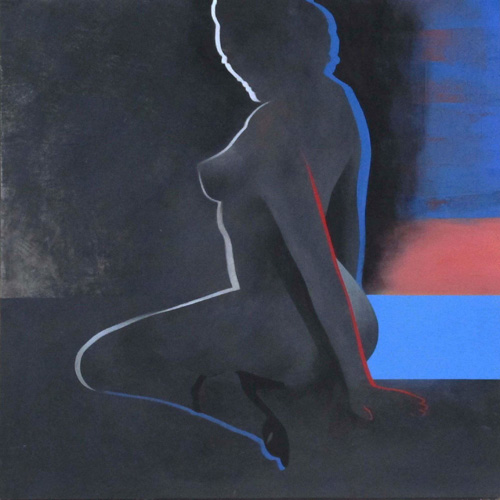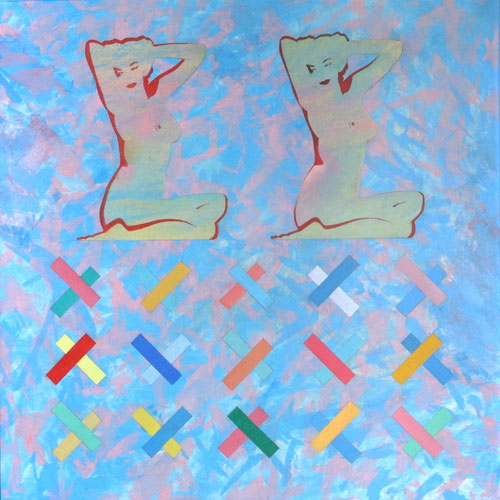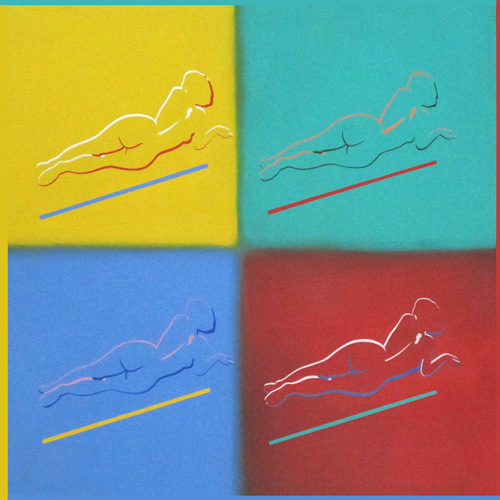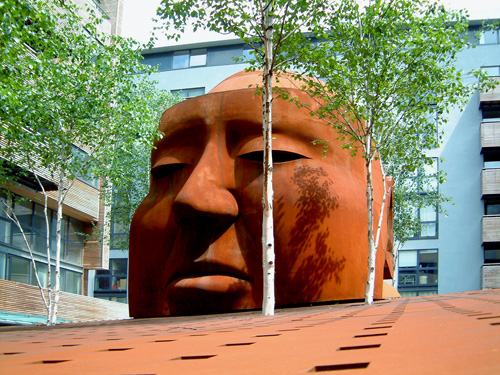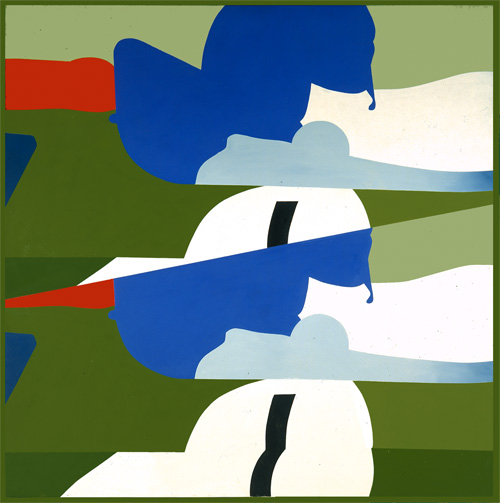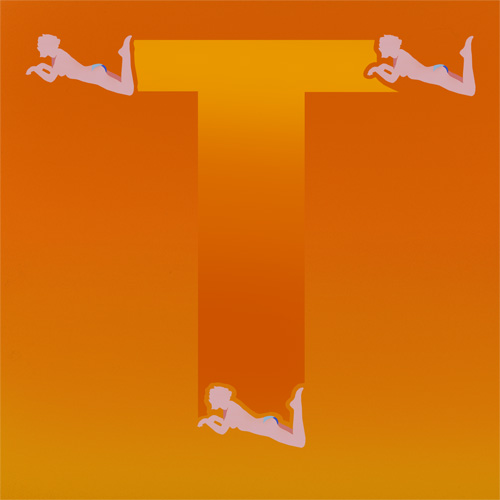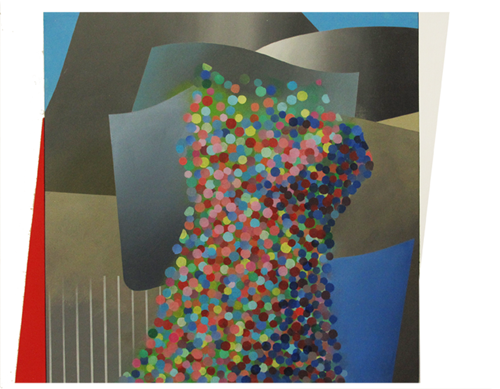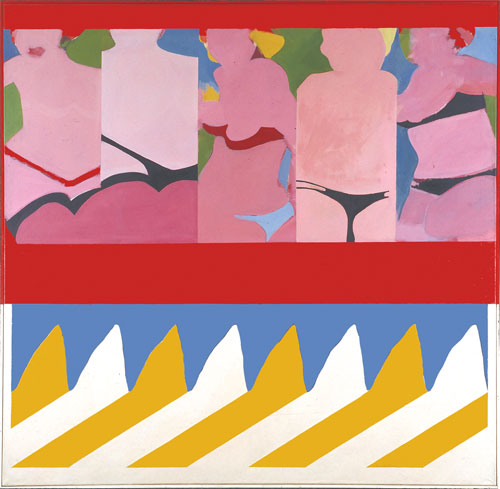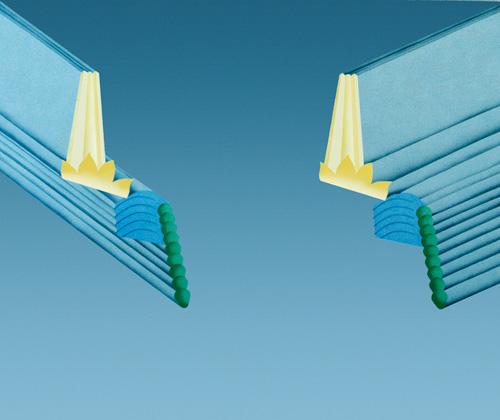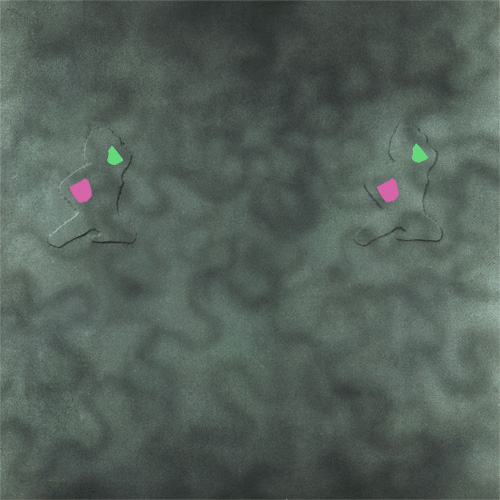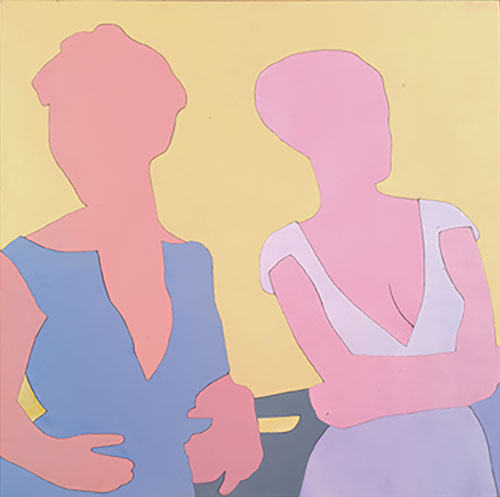

by ANGERIA RIGAMONTI di CUTÒ
Throughout his career, British pop artist Antony Donaldson (b1939) has appeared as intent on pure form as subject matter in his graphically assured silhouettes portraying the allure of modern urban life: art deco cinema facades, mirage-like Hollywood searchlights, motor racing, planes, architecture and, above all, female pin-ups characterised by an aloof eroticism.
Since his euphoric early works, produced during London’s postwar reawakening, Donaldson has continued to use lucid colour, with increasingly finely gradated and painterly finishes. He has also worked in sculpture, as in his monumental, in every sense, portrayal of Alfred Hitchcock on the former site of Gainsborough Studios in north London.
Angeria Rigamonti di Cutò: I wondered what London was like in the 1950s when you arrived, both in terms of the impact of the city and your education. Did being at the Slade rather than the Royal College of Art ultimately make a difference to your path? Of the major British pop artists, I think only you and Colin Self were at the Slade.
Antony Donaldson: And [Eduardo] Paolozzi and Richard Hamilton.
ARC: They were of a slightly earlier generation.
AD: Yes, of course. But the so-called first generation at the Royal College, people like Dick Smith, Peter Blake, Joe Tilson, were gone by the time the people that I knew were students, Peter Phillips, Patrick Caulfield, Allen Jones. Actually, Allen Jones didn’t last very long at the Royal College either. They were studying at exactly my time, but at the RCA rather than the Slade.
ARC: And arriving in London itself, which was the first of a series of journeys you made? Before we get to the 60s, how would you describe the prelude; what was it like before the transformation?
AD: My childhood was basically fractured. My father was a fighter pilot who was killed in the war. He was missing presumed dead so my mother’s pension did not exist because it couldn’t be proved he had been killed. There was no money, so she had to get a job and I had a nanny who looked after me for the first five years. Then I went to boarding school at five and my mother married a test pilot who was killed a couple of years later in a plane crash. It was fraught. My childhood was mainly spent at boarding school, and in the holidays I would stay with Uncle This or Auntie That. Mum was having quite a hard time and I was the only child of all three of her marriages. I didn’t have a childhood that was based on any one place. Then my mother married again and I went to London in 1955 or 1956. Rationing had only stopped in 1954 and London was covered in bombsites. There was virtually no nightlife, there was a little traditional jazz but nothing was really happening at all. I went to art school, first to Regent Street Polytechnic for a year. I had no money so I worked that whole year every night in a restaurant, from about five to 11. Then I went to the Slade. I applied to both the Royal College and the Slade and I got into both. I very much liked William Coldstream who was head of the Slade at the time. At that time, your fees were paid; because I’d been self-employed for a year my scholarship wasn’t based on my parents’ income, they would have been means tested. But because I’d worked I got a full scholarship, which was great, and I had five years at the Slade.
ARC: It’s interesting what you say about Coldstream: one tends to have a facile image of young-gun pop artists rebelling against these traditional figures, but the reality must be more complex?
AD: All generations do that. What you do is you learn a bit from them, and you reject other bits. There were some good people teaching there: Frank Auerbach, Mike [Michael] Andrews, Myles Murphy. There was good teaching, not in an aggressive way, but advice, talking about things, making you aware of the possibility that you could be a professional artist. I did four years as an undergraduate and a year as a postgraduate. While I was a postgraduate I was paid for by University College, but I spent the whole time by then painting at home, the whole last two years. I was painting big pictures so I couldn’t take them into school for my tutors to see, so they came to my house to see what I was doing.
ARC: What – home visits?
AD: Yes, home visits! I was talking to a much more recent artist the other day who said that would be impossible now; you’d be lucky to talk to a tutor for one minute … But then it was really just a great liberal education; you had a lot of time to think about things, to do things, you were in the centre of London so you could see a lot of things. The whole atmosphere of London was changing by then. I started at the Slade in 1958 and the whole of London changed between when I arrived and when I left. The last year, when I was a postgraduate, I was teaching at Chelsea College of Art and there was an amazing burgeoning of cinema, music, writing, poetry and art.
ARC: So from what you’re saying, swinging London wasn’t some laboured media invention …
AD: Well, I’m sure it was, but it was a media invention long after it had passed. I left London in 1966 and it was getting a bit much, or perhaps it was just that I had an opportunity, a fellowship to go to the States. So I thought I’d do that and I left.
ARC: Before you leave for LA, can we talk about some things that were happening in London. What, for instance, was the impact of the now mythic This is Tomorrow show at the Whitechapel Gallery in 1956, which you presumably saw as a student?
AD: I saw it while I was still at school. The great thing about the Whitechapel was Bryan Robertson – people can’t praise him enough – he put on some fabulous shows, fabulous to all us young artists. I think the first show I saw there was the Nicolas de Staël.
ARC: I wanted to ask you about that show. I would imagine [Jackson] Pollock and [Willem] de Kooning meant something to you but I think de Staëlalso made an impact on you. He’s such an interesting artist in that fine line he treads between the abstract and the figurative, something you also do. What was it about him that appealed to you?
AD: When you looked at his paintings, you thought it was something that you could do – not literally, but you thought something like that was possible. It wasn’t like looking at someone who has a massive amount of craftsmanship or something that required thousands of hours of work, this was immediate painting, which really impressed me. It was before the first show of American painting, which I think was in 1958, so I didn’t know anything about it yet. I’d seen little reproductions in Art in America, but to see a Jackson Pollock 4 inches by 4 inches –
ARC: – means nothing.
AD: – and to see one 12 ft is a whole other thing. So de Staël made an impact on me before the American painters. Bryan did a fantastic Pollock show, in 1958 or 1959, he showed Rothko too. Because I’d seen the Pollock show and a few others – [Kazimir] Malevich too I seem to remember – I just couldn’t get This is Tomorrow. I had no idea what the hell they were doing.
ARC: In a good way? Were you still somehow intrigued?
AD: No, I really couldn’t even begin to get around it. I could see there was a lot of stuff happening but I couldn’t understand what they were going on about. Then gradually when I started painting (I’d seen the show before I actually started painting), it became important. It was a very important show looking back on it, just in its attitudes. It’s complicated …
ARC: Some of the environments were meant to illustrate the information theories of Marshall McLuhan, which are complicated, never mind having to translate them into concrete displays. Eight years later, you were participating in another of Bryan Robertson’s influential shows, The New Generation. To understand how these moments were perceived at the time, did you get a sense that this was something that would change things, did it feel groundbreaking?
AD: Once you start on the journey, you cease to think about breaking new ground. When you’re a student, you’re looking at art, at paintings and you’re being influenced by them, it’s all part of learning. Then, suddenly, you’re showing paintings and doing exhibitions and in your head things have changed, you don’t think you’re breaking new ground. But the first show was interesting, it was the first time someone had put the energy and the money into producing shows of people who were pretty unknown. We all had had maybe one or two shows but we weren’t well known.
ARC: You were also very young …
AD: Yes, I actually was the youngest person there, or maybe it was Peter Phillips. From that time, things changed, young English painting became acceptable. Then there was the Paris Biennale where I showed with Bridget Riley, John Hoyland and Patrick Caulfield.
ARC: You also exhibited in the Milan show London under Forty in 1966, another European recognition of British painting. What, if any, was your relationship with what was happening in Milan: were you interested in people like [Lucio] Fontana and [Piero] Manzoni? There’s a tendency to make neat distinctions between movements of the 60s avant gardes, but the reality was presumably much more fluid, with exponents of the various groups encountering one another, whether directly or through exhibitions or reproductions?
AD: Not really, I would have liked to have met them but I think Fontana had died by the second time I was there, Carla Pellegrini had showed him. I was there two or three times. I went back in the early 70s and did some prints there.
ARC: Yes, she described these as “unusual” prints. I wondered why?
AD: There were six prints and the interesting thing about them was the background, which, read from left to right, went from red to blue, it went through the spectrum. We used a massive Heidelberg press that shimmered. You put red in one side, orange in the other side so it printed with the gradations from red to orange. But the downside was, because it was such a massive press that was used for Vogue, no one said that the ink was fugitive. So people who have them, like my great friends in LA, Ed Ruscha and Joe Goode, have kept them in their plan chests so they’re immaculate. But for people who put them on the wall, they faded quite quickly, so I never made prints like this again. I don’t know if they were unusual but they’re good. One of my sons has got the whole set on a wall, with UV glass – no one thought about that at the time – and they look pretty good.
ARC: Before we talk about your nudes, I was interested in another source of yours in the 60s: car racing. Richard Hamilton paid homage to Chrysler but you celebrated British design and the driver Jim Clark. Was it the look, the design that appealed to you, and the movement, rather than the sport as such?
AD: Of course, I’m not a particularly sporty person. People talk about the swinging 60s, the music and theatre, poetry, writing, but they forget there were also brilliant engineers. One of them was Colin Chapman, who completely changed how a racing car was designed – it was quite spectacular. By this time we had two very small boys that we bundled up to go to car races in the country. There was this extraordinary driver, Jim Clark, who was just massively better than anyone else. He would get into any old car, a Formula One car, a saloon car, a sports car and would win everything. So I painted about five or six paintings of him on canvas and about 15 or 20 paintings on paper. It was also to do with this idea of colour moving through a landscape, a sudden movement across your field of vision, which I really liked, it was the English landscape as you’d never seen it before.
ARC: Because presumably, in this context of a rather dour 50s and early 60s London, there wasn’t much in the way of landscape …
AD: The only thing at the time in London was the advertisements, if there were any, on the side of the road, or the girl images outside strip clubs. And the food, and the cars that were beginning to be sold. So that was what you looked at essentially. By the time I got to London, I was bored with the country. Now, of course, I’m living in a completely isolated, rural setting with just a river and nothing else.
ARC: In 1966 you went to Los Angeles on a Harkness scholarship and became very taken with the art deco cinema palaces. London and its suburbs had deco palaces of their own, obviously in a radically different setting. What was the impact of the US after having just seen it in magazines and movies?
AD: It was a bit more complex than that. When you apply for the Harkness, you have to say what your proposed programme is. It was for postgradute scientists and doctors, so you would say: “I’m going to Cal Tech to study physics under Professor Feynman.” It’s a two-year programme, you do a year at university, then travel around, then repeat. My proposal was to work in an American environment, full stop, rather than study anywhere formally. So we arrived in New York, with two boys who were three and five. We saw the painter Paul Huxley and talked to him a bit, as well as a couple of other artists. In the 60s, New York was very dangerous and I didn’t want to bring up children there so we just got in the car. The idea was to drive to LA – of course, there’d be palm trees, which appealed to me, nothing to do with cinemas. Coming from England, palm trees sounded good. It took us two months, and there were quite a lot of places we liked on the way. We liked New Orleans very much and nearly stayed there, but didn’t in the end because although the music scene was great, the art scene wasn’t so apparent.
We got to LA, I’d already met a couple of LA artists in London. One was Joe Goode and the other was Ed Ruscha. When I arrived, I had to start from scratch, which first meant finding a studio. I drove around and found one on Sunset Boulevard – the tacky end – it was an old carpet showroom, which was fine, a big open space. Then you had to drive around to find somewhere to buy canvas but it was the middle of the Vietnam war and the American army was taking all the canvas for tents, so it was a bit of a struggle to find it. For the next couple of weeks I drove around, talking to people about where to find paint and so on.
At the time, LA was really suburban, everything was low and then suddenly you’d be driving around, the valley, or towards Glendale, and see these cinemas rearing up among these shacks. So I started taking photographs of them, they interested me and the light was fantastic. Then I started a whole series of paintings on them and showed them at the Nicholas Wilder Gallery. One of them came back to England to be shown at the New Generationinterim exhibition in ’68.
ARC: It’s interesting the way you excised just one specific element of those deco dream palaces for a series of works, the architectural projections and placed your pinups on the ends, like paper dolls. It’s a very unusual combination of the nude and architectural drawing that I don’t think I’ve encountered anywhere else. Why was that detail important to you?
AD: Funnily enough, the thing of the isometric projections initially happened before I went to America. There were three or four paintings. One of them, Six o’clock Cadillac, has two girls on a projection coming out of each corner; another was Bell-in-One and both were shown at the Rowan Gallery after I left – Jeremy Moon hung it for me and there were various discussions on how high or low the works should be placed. But what really impressed me about these architectural elements and changed the way I thought about them was something I saw when we first drove into LA on the freeway looking for a motel. It was dark and the whole city was spread out before us in a patchwork of light. Somewhere, sort of top right in my vision there were searchlights tracing through the sky, an image that deeply impressed me.
ARC: A title of one of your works, although not an architectural image, struck me as perhaps being illustrative of an interest you show in the tension between surface and depth which the projection works seem to address: It’s a relief to get away from the surface.
AD: For that work, I very accurately cut out two girl shapes in plywood, stuck them on to the stretcher and stretched the painting over them, then sewed cotton to pull them back so that the canvas went across the surface, tucked down over it, so the whole thing is a relief on a piece of canvas. When I did a show at the Mayor Gallery in ’99, the critic Mark Glazebrook took me to see the painting – a friend of his had it – and it was quite a shock to see it. It’s a camouflage painting, apart from the two small patches of colour on each side. The title, It’s a relief to get away from the surface, was tongue in cheek because, of course, it was literally a relief.
ARC: Let’s talk a little about your pinups, which are a constant presence. You don’t seem to use recognisable popular stars as many of your contemporaries did and your nudes are interestingly remote and depersonalised.
AD: They’re meant to be. Thinking about them just as images, they’re complete, they’re never just bits of things. I like the idea of being able to paint a whole image, without cutting it here or there. At the beginning, they were more blatantly sourced from strip clubs, but after a while they became much more abstract and still remain so. I like girls.
ARC: Nothing wrong with that …
AD: Exactly. But sometimes critics seem to have to excuse these nudes, in my work or in the work of artists like Mel Ramos, Tom Wesselmann and Allen Jones.
ARC: The nude often seems like a pretext for something else, its character is completely different in each of those artists. Yours certainly seem totally dissimilar to Jones’s fetishistic models.
AD: But they weren’t at the beginning. I’ve known him all my life. The first paintings I ever saw of his were the bus paintings, but his work wasn’t as extreme as now. There’s an article out soon where they ask me about this, about women’s liberation, street art, neither of which I’m involved in. I told them I never noticed anything in Allen’s imagery that would be upsetting to women until he used them as furniture. Then the climate changed. I have been attacked but I’ve never had a statement about my using women as objects or anything like that.
ARC: It does seem that your nudes are rather abstract and stylised. You get the sense they could be about different things, about the content, the form and the play between the two, coincidentally sometimes seen as one of the interests of pop art. I’m also reminded of Kenneth Clark’s distinction between the naked and the nude.
AD: But do you think he knew what the difference was? I did a series of paintings on aeroplanes which showed in Paris and, again, it’s just an image which is whole that appeals to me. I went to Reno to the aeroplane races just to have a look – not the year everyone died – and made these images that could be manipulated and pushed in a way. I also did a whole series of “tourist” pieces, things that you find as a tourist, images that you like, but they were always complete images, they were never just bits of them.
ARC: Does that series include your images of the Frank Gehry buildings?
AD: Yes, absolutely. In actual fact, there were two Gehry buildings in that series, the Guggenheim and the Disney, some with a dog and the ones with Mickey Mouse. I live quite near Bilbao and have been coming to this house for years so I would drive up and down the Spanish coast but always avoided Bilbao because it was such a horrible place. Suddenly, they built Gehry’s museum and people’s concept of Bilbao completely changed. Perhaps the Sydney Opera House changed what people thought about Sydney, or the Tour Eiffel, one building can change the whole perception of a city.
ARC: I was also reminded of Richard Hamilton’s series of images of [Frank Lloyd] Wright’s Guggenheim – did you have that in mind as well?
AD: No, not at all but perhaps the motivation was similar. I was also interested in Zuni fetishes, pre-Colombian pottery, Japanese gardens – I’ve spent quite a lot of time in Japan – and some faces of tourists themselves. And the dog paintings, I think that dog is quite extraordinary, it has an amazing presence. When you travel and look at things, sometimes they come back and haunt you, so you go back and paint them. It’s a peg to hang it on.
ARC: You also explored the nude in animation in your short film Soft Orange, in a really unusual way I can’t compare to anything else, though it reminded me slightly of the speeded-up sex scene in A Clockwork Orange, that mixture of eroticism, comedy and slight unease.
AD: The artist Bob Graham who I made it with was a great friend. We arrived in LA at the same time, I had crossed America and he came from San Jose. I was taking photographs and I was also starting to film LA and Las Vegas. He was making these little wax figures of girls: he had a show at the Whitechapel in ’70. We decided to make an animated film together but the wax figures fell to pieces so we had to build a skeleton for them to hang on. It took a long time – for one second we’d have to do something like 32 movements.
Someone mentioned that when we sent it to the processing house, they might destroy it or call the police saying it was pornographic. At the time, there was a famous case of an artist, Wallace Berman, who had a show at the Ferus Gallery in 1957 which was raided by the police who accused Berman of using a pornographic image in one of his assemblages. This was his last one-man show. He left LA, he was a nice man and a good artist and it was quite catastrophic for him. Anyway, Bob had this idea that we’d do this as a pilot and then go on to make a full-length feature, which was nonsense of course. But we thought we should look into this thing of pornography.
I’d left England where there’d been that massive trial about Lady Chatterley’s Lover just a few years earlier. Everyone was questioning whether it was depraved, there was a whole intellectual argument about censorship (it’s actually not a very good book), whether censorship could stop depravity, without questioning whether people were already “depraved” before looking at the work.
Someone suggested that we go and see Russ Meyer, the director of very over-the-top films. We went to see him and his Playboy model starlet wife-to-be, at his house with a big pool and everything. He was charming, and explained his system to dodge the censors: “I never have any problems. First, I shoot a couple of feet of film of the wife and kids in the swimming pool [a complete fiction, the “wife” was naked and there were no kids]. I would then film what I wanted to film, then put a couple more scenes of my wife and kids at the end, send it off to Kodak and they’d print it, no problems.”
But Bob thought it was too risky so I suggested going to the Beverly Hills sheriff’s department. Being half-Mexican in the 60s he hated all thoughts of police so I ended up going alone. In the department they wore these dark-khaki tops with blue and gold flashes all over, jodhpurs, boots and spurs, hats and mirrored glasses. So there were a couple of these guys behind the desk and I said I’d like to talk to someone.
“What about?”
“About pornography.”
“Upstairs, second door on the right.”
Upstairs there was another guy, dressed in exactly the same way, feet up on the desk. I wasn’t sure what to say so I asked him for a definition of “pornographic”. He said it was simple: if there were two people together naked in a room who were seen to touch each other below the waist, it was pornography. It seemed so easy after all that debate about people being “contaminated” by ideas and so on.
ARC: But within those limitations, you seemed to get away with quite a lot …
AD: Strictly speaking, we stuck to that, there were torches, but the rule was incredibly specific and I was very careful about it. In the end, we realised it wasn’t going to go anywhere. Some money was put into it so it was released. MoMA bought some copies, as did the Arts Council, the Leeds Citizens’ Committee decided it was obscene and banned it. The Arts Council gave me some money to make another film, Pix. The other thing was we didn’t have permission to use the music so when Soft Orange was recently published online, permission was bought and I was really pleased that Albert King is credited.
ARC: And you weren’t tempted to explore moving images further after that experience?
AD: I started another film called Blue, which was about five girls in a pool. But it all became too complicated.
ARC: In 2007 you did another nude series, the French Paintings, based on Ingres’s Le Bain Turc. Richard Hamilton once said that the Playboy pin-up provides the closest contemporary equivalent of the odalisque in painting. Before and since the French paintings you’ve used the playmate prototype but this seems to be the only instance in which there’s a discernible element of old master painting in your work. Was this just a starting point for you to develop a different kind of nude?
AD: I’m not sure. To go back to what I call the “Beach” paintings, I’d spent the summer in St Tropez and had taken a lot of photographs and the whole setting reminded me of the Ingres Turkish Bath. I started a painting in 1976, a round version of the Ingres but transposed outside to Tahiti plage. I never finished it but every now and then I’d bring it out, but the problem was the paint I used no longer exists. It was acrylic lacquer which the Americans started using first for custom-car painting around the time I was there in ’66 and ‘67, people like the designer George Barris. It was fabulous paint but it had chemical problems so you can’t get it anymore and I could never finish that painting. But in starting the new series it was like starting it again. Marco Livingstone wrote a good piece about that series in the catalogue.
ARC: Many of your titles in that series refer to literary and visual modernism: Beat poets, TS Eliot, Lorca, van Doesburg– are you often thinking about other artistic forms when you produce your work?
AD: That’s what I read, that’s what’s around me. There’s a painting in the series called Everything I do is gonna be funky, the Allen Toussaint song. It was playing when I painted it so it had to be called that. It’s the same when something’s going through your mind when you’re working and I mostly work with music. Titles come and they also make it easier to identify a painting.
ARC: And the fact that you use repetitions of motifs, and sometimes musical titles, seems like a way of creating some kind of performance in the work.
AD: Maybe. The repeat is a very simple thing that started a long time ago: it interests me to put two identical images next to each other and see what happens with them. You get shapes between two images that are completely different on the left and right hand sides of the painting, it creates a kind of tension.
ARC: I don’t believe you’ve ever used collage, as many pop artists have. But you have worked quite a lot in sculpture, for example in your extraordinary Hitchcock statue.
AD: I like that piece, it works and it goes on working, but it’s the last time I’ll work on a large sculpture. When you have eight people working for you, you have to think about what they’re doing so I never thought about what I was doing. I like to paint now, painting’s a singular thing.
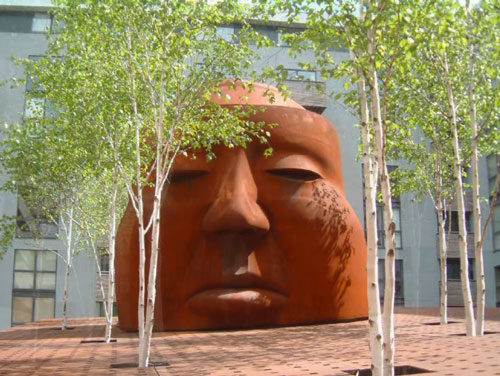
Antony Donaldson. Flicker Book One.
ARC: It’s interesting that you usually avoid recognisable, particularised faces, but here you struck a brilliant balance, a likeness of Hitchcock that also teeters on the brink of abstraction.
AD: It also teeters on Buddha …
ARC: Absolutely.
AD: It had to. I was asked to do something for Gainsborough studios so it was my idea to make it of Hitchcock. But London’s full of monuments to people looking like the people and I wanted it to be much more spiritual. I was in Hong Kong and I went to see this enormous Buddha on the top a mountain, absolutely vast. It wasn’t particularly good but it was impressive so I thought the sculpture should be Buddha-esque, also because Hitchcock has that sort of quality.
ARC: Which you realise about him as soon as you see the sculpture, you see something you’ve always seen but perhaps couldn’t define. At the same time, it was intriguing to see that you could do a recognisable portrait so well, albeit a very particular one, something you had more or less always avoided.
AD: The other thing is, it’s got a mask, the face is a mask, while the ears and the back of the head are almost like a cubist piece. It’s like two pieces joined together so there’s this dichotomy between being realistic in one way and idealistic in another.
ARC: Your current show, Of Memory and Oblivion at the Mayor gallery, has some elements that make one wonder how living in the south of France affects your work. One of your titles is Where the light is strong, and, like other works here, its colours are very saturated. Are these elements of light and colour linked to that location or not, because in some ways your images seem to occupy their own, quite unreal world?
AD: The place does have an effect on me. The land is beautiful and we’re very happy here but we also live right in the centre of London, surrounded by people, theatres, cinema and so on, in contrast to the complete isolation here. And the thing about the saturated colour, we’re on the Atlantic coast, so that’s not the Mediterranean; it’s a much wetter climate even though it’s right by the Spanish border.
ARC: Finally, what’s your experience of being inevitably associated with a now historic movement like pop art? You’ve continued to work and evolve, so does being related to a particular group seem limiting or irrelevant?
AD: I don’t know. Journalists make up terms about what one does. I think it’s for other people to answer. I’m a painter, that’s what I do every day and nothing’s changed much. I’m very happy that’s what I do, it’s the only thing I’ve ever done and I don’t know anything else.
• Antony Donaldson: Of Memory and Oblivion, the Mayor Gallery, London, 9 September – 9 October 2015
